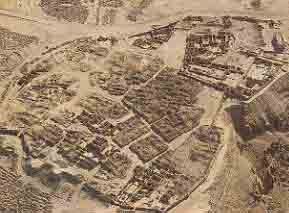Image Details

Richard Cleave
Islands of dense house ruins identify the town of Mampsis (Mamshit) from the air. Formerly a caravan stop, Mampsis grew to a town during the Late Nabatean Period (late first and second centuries A.D.), when the Nabateans turned from nomadism to agriculture and began to settle in towns. Private dwellings crowded together in blocks separated by wide streets replaced the open plan of the old caravansary, with its public buildings spaced at large distances from one another. The absence of large public buildings adaptable to churches, forced the later Christians at Mampsis to construct their churches on the town’s outskirts; the best-preserved churches appear at bottom center and at the far right, by the edge of the cliff.
The water that made agriculture possible at Mampsis came from Nahal Mamshit, lower right, a wide wadi that deepens into a gorge just east of the town. The Nabateans solved the problem of collecting the wadi’s limited and irregular flow of water by constructing three dams in the shallows (see photograph). Behind these dams, water accumulated to form pools as large as 13,000 cubic yards in volume, enough to fill 5 olympic-size swimming pools. The water collected from these pools could be stored in cisterns for use during the dry periods. Today, silt replaces water behind this dam.
